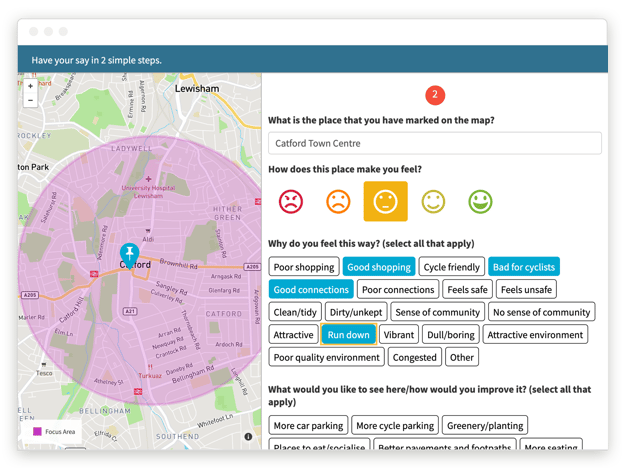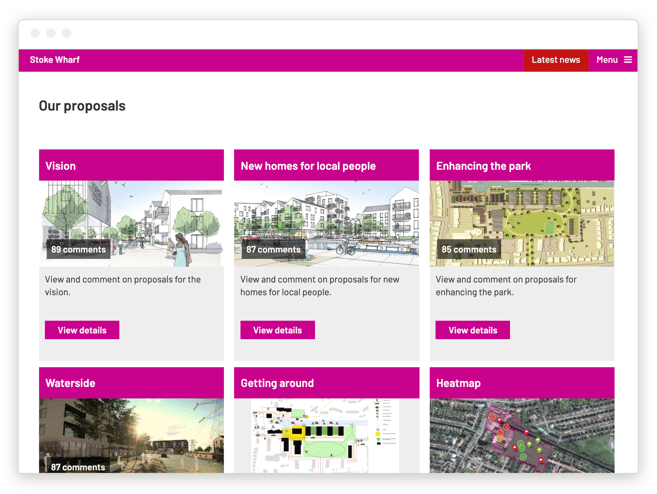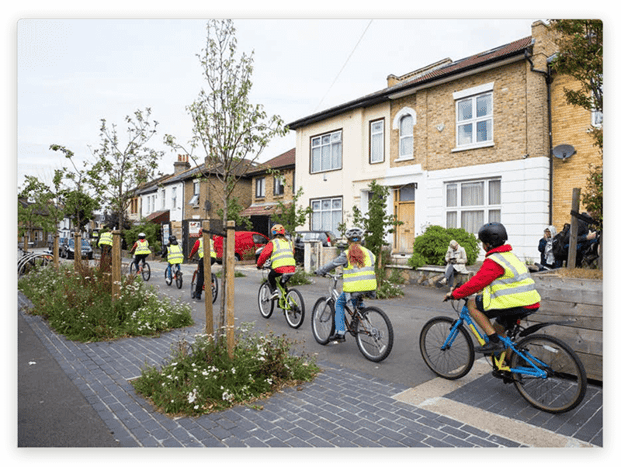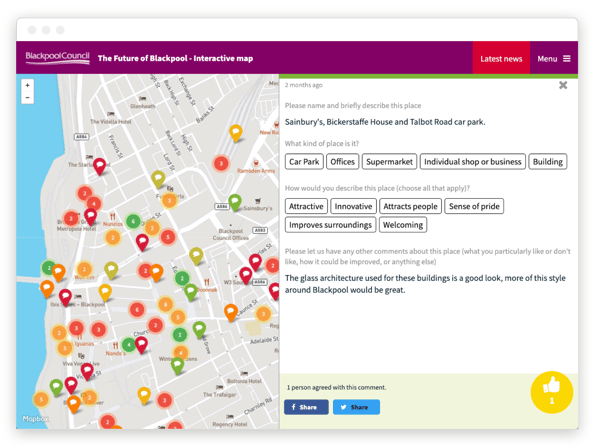5 Best practice examples of digital community engagement

By Fred Gulliford | 08/09/20 11:20
4 min read
Since the coronavirus pandemic struck, many companies have been utilising digital engagement methods to ensure their planning proposals are still able to go ahead. In testing times and through this period of uncertainty, we have seen huge innovations as people are embracing digital engagement more than ever before.
But what are the best practices? If this is a new area for you, Commonplace has been working tirelessly to support various organisations to engage with their local communities and as such, we are able to offer a range of inspiring initiatives.
1. Catford Regeneration
Community engagement
Located in South London, Lewisham Council needed insight into what its residents and visitors thought about the area of Catford and any changes they would like to see made.
In order to really help further their objectives, the council used our Community Heatmap tool. This has allowed individuals to share recommendations by pin-pointing areas they would like to see changes made.
Using the Commonplace platform, the Council have been able to post regular updates and news about the project and build up a base of over 700 subscribers who they gather insight from and share key information with.
This community engagement initiative has seen over 23,000 unique visitors to the Commonplace site, with a total of 12,500 contributions made to date. Catford achieved recognition of their approach in the Building London Planning Awards 2020. They were commended for their creative approach to community engagement and the use of Commonplace's digital platform to keep their residents involved in the conversation. Visit the project.
Key learning:
Heatmaps bring a visual aid to planning and engagement, encouraging higher levels of interaction.
2. Connecting Leeds
Transport planning
Part of the much bigger ‘Connecting Leeds’ campaign, Leeds City Council decided it was important to understand what temporary measures they could implement to make essential walking or cycling trips safer for the public throughout the coronavirus pandemic. They wanted to find ways to help people to keep two metres apart and protect the health and safety of the public.
Whether it's a dangerous blind spot that needs addressing, a new cycle route, or inspiration for creating quieter residential streets, Leeds Council decided to use our Community Heatmap tool to collect suggestions from local residents.
This extremely successful project has allowed Leeds City Council to digitally engage with their local communities during lockdown, leading to 19,000 unique visitors who have left over 26,000 contributions.
In response to community feedback, Leeds council has laid out its ambitious plans to promote active travel. This includes an additional 100km of segregated cycle lanes, active travel neighbourhoods and temporary widened footways. Visit the project.
Key learning:
Even temporary measures can be analysed with the help of digital engagement tools.
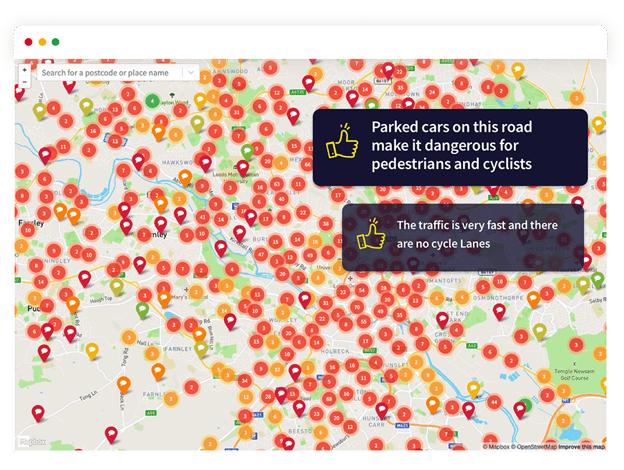 (Proposed new active travel infrastructure in Leeds)
(Proposed new active travel infrastructure in Leeds)
3. Stoke Wharf
Planning Consultation
In July 2019, Slough Urban Renewal (joint venture between Slough Borough Council and Morgan Sindall Investments) and Waterside Places, (joint venture between Canal & River Trust and Muse Developments) announced plans to regenerate the Stoke Wharf area.
They decided it was extremely important to gain insight from everyone within their local communities, across a diverse audience, not just those that are more inclined to speak up.
At Commonplace we worked closely with them to access these local communities digitally through the use of our Community Heatmap tool.
The mixed use development for 270 new homes, retail and landscapes spaces, gained an exceptional engagement throughout the project timeline.. The 378 contributions received from 2,756 people that visited the heatmap were then used to inform more detailed proposals, which were shared with the community for further comment. This example of civic engagement and two-way dialogue allowed them to build a rapport with their community and develop a sense of trust in the project. Visit the project
Key learning:
Initial learnings can form the basis of more detailed proposals. By making engagement activities regular, but by asking for less information than traditional surveys may entail, respondents from all areas and levels of interest are likely to engage.
(Stoke Wharf proposals, Slough Urban Renewal)
4. Waltham Forest Mini-Holland
Transport planning
The London Borough of Waltham Forest invested in a programme to radically improve cycle routes and public spaces across the borough.
Due to the controversial nature of the programme, it was important that the Council were able to gain insight from a broad audience and allow residents to share their range of views in as transparent a way as possible.
Therefore, for each of the 10 focus areas, Commonplace created an online perception survey. This allowed the council to digitally engage over 15,000 people from 10 different areas in an 18-month period.
We then created a strong feedback loop between the residents and the council, using infographics to communicate key points, to allow for complete transparency. This saw 72% of respondents either neutral or in support of the proposals. Visit the project.
Key learning:
Digital engagement can be undertaken even for projects that have some level of controversy. Careful planning of execution allows each project to be handed in a way that keeps the dialogue collaborative and productive.
5. Blackpool Towns Fund Regeneration
Blackpool is one of the 100 towns in line to benefit from the recent Government ‘Towns Fund’ scheme, bringing in a significant investment to help the town grow back stronger following the impact of COVID-19.
The team at Commonplace have been working closely with the Council during lockdown to help produce their investment proposal plan. For this to be successful, evidence of digital community engagement was paramount.
Utilising Commonplace’s Community Heatmap and Design Feedback tools, they have gained insight from over 6,911 people, who have been able to leave 2,163 contributions from the safety of their homes.
Visit the project.
Key learning:
Digital engagement has shown its merit during the restrictions on movement faced in lockdown. Acquiring insights from nearly 7000 people in a short time frame using traditional engagement methods would simply not have been possible at a time of social distancing and the inability for face to face meetings to take place.
As you can see, digital engagement is different for each customer we work with but the results are the same – predictably high levels of engagement, surpassing traditional methods, and tangible benefits. Are you looking for ideas on how to successfully engage with your local community? Get in touch with the team today and see what Commonplace can do for you.
Organise a free, personalised demonstration
